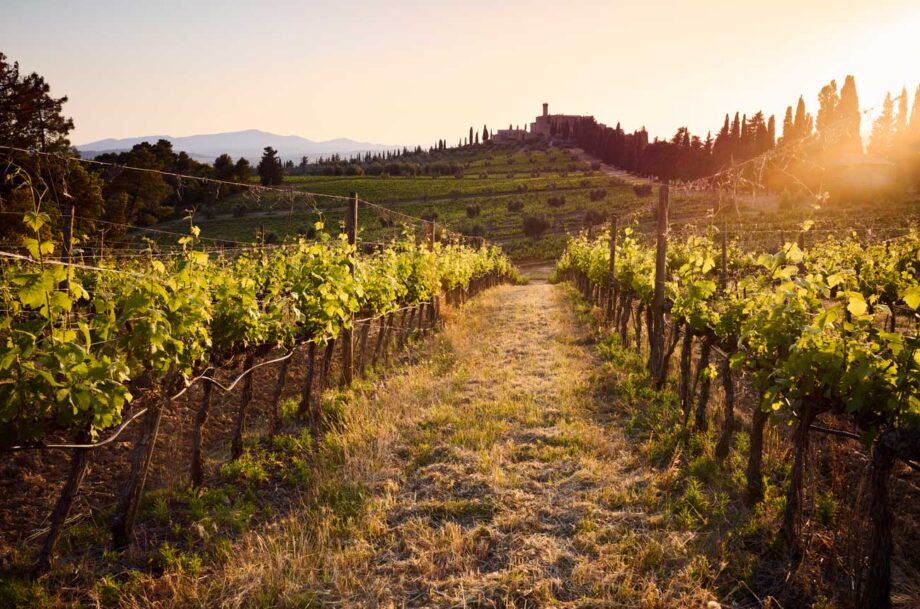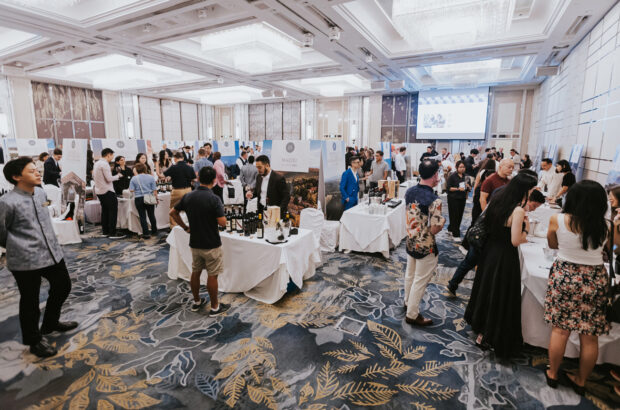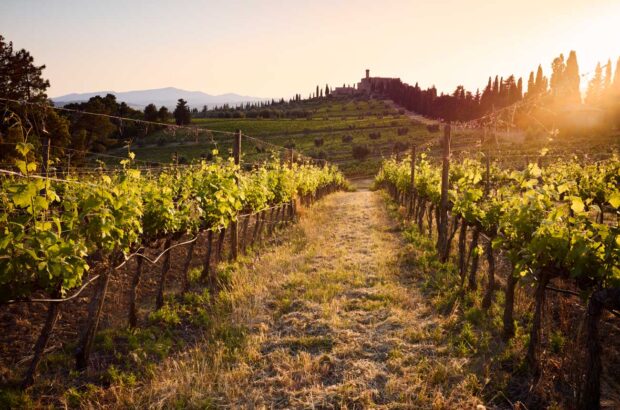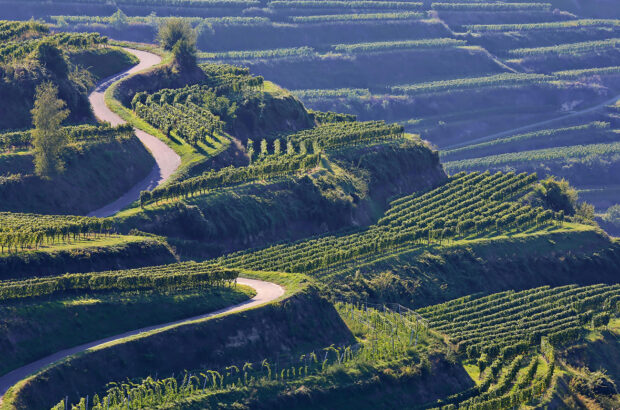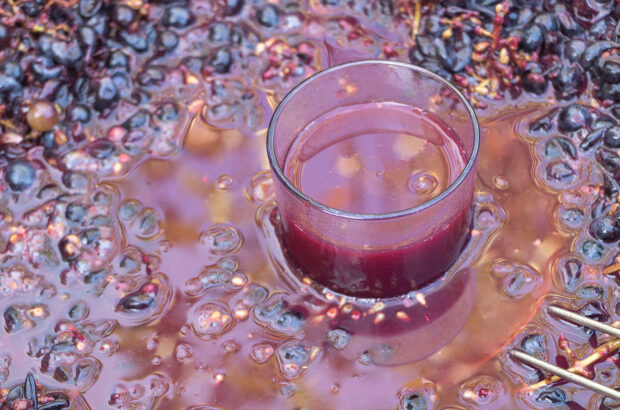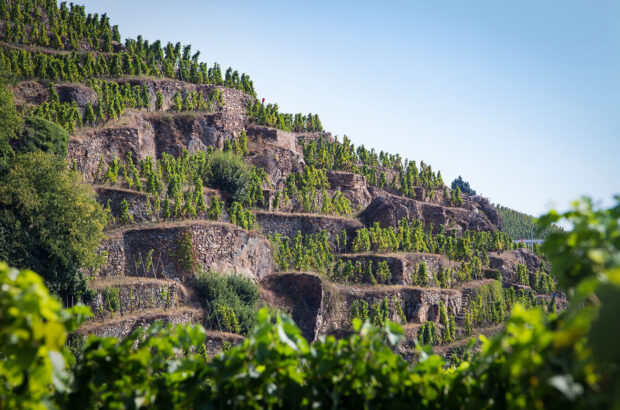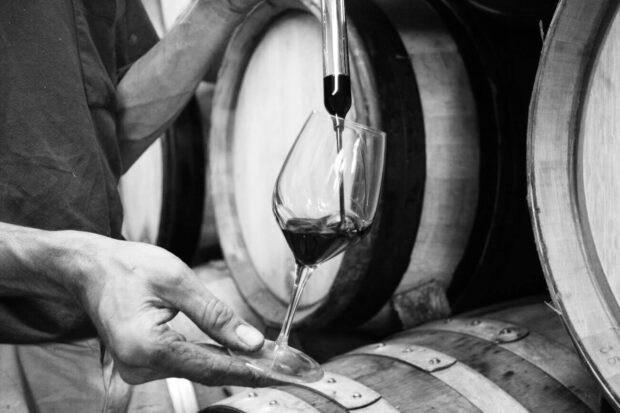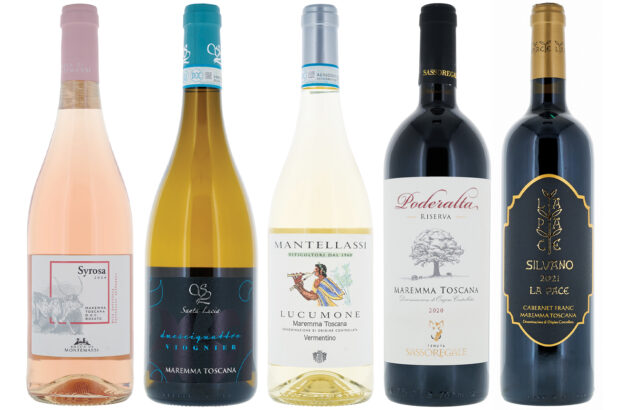Terroir as a concept originated in the Middle Ages, when describing a wine as having ‘the goût de terroir’ was often disparaging: literally, the taste of dirt. Appropriate, then, that terroir today has become as common as muck.
Yet as late as the 20th century, it was of little interest to wine writers. George Saintsbury’s Notes on a Cellar-Book (published 1920) doesn’t mention it. In Alexis Lichine’s Wines of France (1951) there’s an index entry for terrine de lapin but not for terroir; André Simon didn’t think it worth including in his otherwise comprehensive glossary to The Noble Grapes and the Great Wines of France (1957).
{"content":"PHA+VGhhdOKAmXMgYmVjYXVzZSB0aGUgd2lkZXNwcmVhZCBhcHBlYXJhbmNlIG9mIHRoZSB3b3JkIG9jY3VycyBvbmx5IGFmdGVyIHRoZSAxOTc2IEp1ZGdlbWVudCBvZiBQYXJpcyBjb21wYXJhdGl2ZSB0YXN0aW5nLCB3aGVuIDxzdHJvbmc+PGEgaHJlZj0iaHR0cHM6Ly93d3cuZGVjYW50ZXIuY29tLm1hc3Rlci5wdWJsaWMua2V5c3RvbmUtcHJvZC1la3MtZXV3MS5mdXR1cmVwbGMuZW5naW5lZXJpbmcubWFzdGVyLnB1YmxpYy5rZXlzdG9uZS1wcm9kLWVrcy1ldXcxLmZ1dHVyZXBsYy5lbmdpbmVlcmluZy93aW5lL3dpbmUtcmVnaW9ucy9jYWxpZm9ybmlhLXdpbmUtcmVnaW9uLyIgdGFyZ2V0PSJfYmxhbmsiIHJlbD0ibm9vcGVuZXIiPkNhbGlmb3JuaWE8L2E+PC9zdHJvbmc+IHRyaXVtcGhlZCBvdmVyIDxzdHJvbmc+PGEgaHJlZj0iaHR0cHM6Ly93d3cuZGVjYW50ZXIuY29tLm1hc3Rlci5wdWJsaWMua2V5c3RvbmUtcHJvZC1la3MtZXV3MS5mdXR1cmVwbGMuZW5naW5lZXJpbmcubWFzdGVyLnB1YmxpYy5rZXlzdG9uZS1wcm9kLWVrcy1ldXcxLmZ1dHVyZXBsYy5lbmdpbmVlcmluZy93aW5lL3dpbmUtcmVnaW9ucy9ib3JkZWF1eC13aW5lcy8iIHRhcmdldD0iX2JsYW5rIiByZWw9Im5vb3BlbmVyIj5Cb3JkZWF1eDwvYT48L3N0cm9uZz4uIFRoZSBhZG9wdGlvbiBvZiB0aGUgd29yZCB0ZXJyb2lyIGluIHdpbmUgd3JpdGluZyBpcyDigJMgaXJvbmljYWxseSBlbm91Z2gg4oCTIGEgY29uc2VxdWVuY2Ugb2Ygd2luZSBleHBlcnRz4oCZIGZhaWx1cmUgdG8gcmVjb2duaXNlIGl0IHVuZGVyIGJsaW5kIGNvbmRpdGlvbnMuPC9wPgo8cD5GYXIgZnJvbSBiZWluZyBhIHByb2ZvdW5kIHBoaWxvc29waHkgb2YgcGxhY2UsIHRlcnJvaXIgd2FzIGxpdHRsZSBtb3JlIHRoYW4gYSByZWFyZ3VhcmQgYWN0aW9uIGJ5IHRoZSBGcmVuY2ggYWdhaW5zdCB0aGUgZmFsbG91dCBmcm9tIHRoZSB3b3JsZOKAmXMgbW9zdCBpbmZhbW91cyBibGluZCB0YXN0aW5nLiBZZXQgaXQgbWV0IHdpdGggYXN0b25pc2hpbmcgc3VjY2Vzcy4gSW4gdGhlIGVuc3VpbmcgZGVjYWRlcywgdGVycm9pciB0cmFuc2Zvcm1lZCBkaXJ0IHRvIGRvY3RyaW5lIHRoYW5rcyB0byBGcmFuY2XigJlzIHZpbm91cyBwcmVzdGlnZSwgZGVzcGl0ZSBzY2VwdGljaXNtIGZyb20gZWxzZXdoZXJlLjwvcD4KPHA+QXMgYSB3b3JkLCB0ZXJyb2lyIGhhcyBldm9sdmVkLCBhbmQgaW4gaXRzIGJyb2FkZXN0IGNvbnRlbXBvcmFyeSBtZWFuaW5nIGFzIGEgc2Vuc2Ugb2YgcGxhY2Ug4oCTIGVuY29tcGFzc2luZyBjdWx0dXJlLCBmb29kLCBoaXN0b3J5IGFuZCwgY3J1Y2lhbGx5LCB0eXBpY2l0eSDigJMgaXQgZG9lcyBoYXZlIHZhbHVlLiBZZXQsIGFsdGhvdWdoIHRlcnJvaXIgaXMgbGFyZ2VseSBqdXN0aWZpZWQgYnkgdGhlc2UgaWRlYXMgb2YgaWRlbnRpdHkgYW5kIGRpc3RpbmN0aXZlbmVzcywgdG9kYXkgaXTigJlzIG1vc3RseSB1c2VkIGFzIGEgZmFuY3kgc3lub255bSBmb3IgdmluZXlhcmQgb3Igc29pbCwgYXMgZXZpZGVuY2VkIGJ5IHRoZSBpbmNyZWFzaW5nIHVzZSBvZiB0aGUgcGx1cmFsLCB0ZXJyb2lycy48L3A+CjxwPjxkaXYgY2xhc3M9ImFkLWNvbnRhaW5lciBhZC1jb250YWluZXItLW1vYmlsZSI+PGRpdiBpZD0icG9zdC1pbmxpbmUtMiIgY2xhc3M9ImlwYy1hZHZlcnQiPjwvZGl2PjwvZGl2PjwvcD4KPHA+VGhpcyBjcmVhdGVzIGEgZGlsZW1tYSwgYmVjYXVzZSBhbHRob3VnaCBoaXN0b3J5LCBjdWx0dXJlIGFuZCBpZGVudGl0eSBhcmUgaW5jcmVhc2luZ2x5IGltcG9ydGFudCBpbiBhIGdsb2JhbGlzZWQgd29ybGQsIHRoZSBpZGVhIG9mIHNpbmdsZS1zaXRlIGV4cHJlc3Npb24sIHNvaWwgY29tcG9zaXRpb24sIHdhdGVyIHJldGVudGlvbiBhbmQgcG90YXNzaXVtIGNvbnRlbnQgYXJlIG5vdCwgYW5kIG5ldmVyIGhhdmUgYmVlbiwgaW50ZXJlc3RpbmcgZm9yIHRoZSB2YXN0IG1ham9yaXR5IG9mIGV2ZW4gc2VyaW91cyB3aW5lIGxvdmVycy48L3A+CjxwPkNydS1sZWQgZXhwcmVzc2lvbiBtYXkgbW90aXZhdGUgd2luZW1ha2VycyBhbmQgYSBtaW5vcml0eSBvZiBkcmlua2VycywgYnV0IGRvZXMgaXQgZW5nYWdlIHRoZSB0eXBpY2FsIDxlbT5EZWNhbnRlcjwvZW0+IHJlYWRlciwgZm9yIGV4YW1wbGUsIG9yIGRvZXMgaXQgYm9yZSB0aGVtIHdpdGggY29tcGxleCBjbGFzc2lmaWNhdGlvbnMgdGhhdCBjaGFsbGVuZ2UgZXZlbiB0b3Agd2luZSBwcm9mZXNzaW9uYWxzPyBEb2VzIHRlcnJvaXIgZXZlbiByZWdpc3RlciB3aGVuIHlvdSBkcmluayBhIGJvdHRsZSB3aXRoIGRpbm5lciByYXRoZXIgdGhhbiB0YXN0aW5nIGEgbGluZXVwIGluIGEgbWFzdGVyY2xhc3M\/IElzIGl0IHNpZ25pZmljYW50IHRoYXQgYSBzb2lsIGlzIG1pbGxpb25zIG9mIHllYXJzIG9sZCwgb3IgdGhhdCBhIHJlZ2lvbiB3YXMgb25jZSB1bmRlciB0aGUgc2VhPyBIb3cgbWFueSBwZW9wbGUgd2FsayBpbnRvIGEgc2hvcCBhc2tpbmcgZm9yIHdpbmVzIGdyb3duIG9uIGFsbHV2aWFsIG1hcmxzPzwvcD4KPHA+SW4gYW55IGNhc2UsIGZvciBldmVyeSBncmVhdCB3aW5lIHRoYXQgaXMgdGVycm9pci1kcml2ZW4sIHN1Y2ggYXMgYSBzaW5nbGUtc2l0ZSA8c3Ryb25nPjxhIGhyZWY9Imh0dHBzOi8vd3d3LmRlY2FudGVyLmNvbS5tYXN0ZXIucHVibGljLmtleXN0b25lLXByb2QtZWtzLWV1dzEuZnV0dXJlcGxjLmVuZ2luZWVyaW5nLm1hc3Rlci5wdWJsaWMua2V5c3RvbmUtcHJvZC1la3MtZXV3MS5mdXR1cmVwbGMuZW5naW5lZXJpbmcvd2luZS9ncmFwZS12YXJpZXRpZXMvcmllc2xpbmcvIiB0YXJnZXQ9Il9ibGFuayIgcmVsPSJub29wZW5lciI+Umllc2xpbmc8L2E+PC9zdHJvbmc+IHdpdGggYW4gaW5kZWxpYmxlIGNoYXJhY3RlciB0aGF0IHRyYW5zY2VuZHMgdmludGFnZSwgdGhlcmUgYXJlIG90aGVycyB0aGF0IGFyZW7igJl0LCBzdWNoIGFzIGNvbGhlaXRhIFBvcnQsIGEgd2luZSBkZWZpbmVkIGJ5IGJsZW5kaW5nLCBhZ2VpbmcgYW5kIGNhcmVmdWwgY3JhZnQuIEV4cHJlc3NpbmcgdGVycm9pciBpc27igJl0IGEgcmVxdWlyZW1lbnQgb2YgZ29vZCBvciBldmVuIGdyZWF0IHdpbmUuIE5vciBkbyB3ZSByZWZsZWN0IGVub3VnaCBvbiB3aGV0aGVyIHRoZSBhc3N1bXB0aW9ucyBvZiB0ZXJyb2lyIHByZWp1ZGljZSB1cyBhZ2FpbnN0IHF1YWxpdHkgd2luZXMgZnJvbSBlbWVyZ2luZyByZWdpb25zIG9yIGV4Y2VwdGlvbmFsIHdpbmVzIHRoYXQgZG9u4oCZdCBwcmlvcml0aXNlIG5vdGlvbnMgb2YgdGVycm9pci48L3A+CjxkaXYgY2xhc3M9ImFkLWNvbnRhaW5lciBhZC1jb250YWluZXItLW1vYmlsZSI+PGRpdiBpZD0icG9zdC1pbmxpbmUtMyIgY2xhc3M9ImlwYy1hZHZlcnQiPjwvZGl2PjwvZGl2Pgo8cD5EZWZpbmluZyB0ZXJyb2lyIGlzLCBhZG1pdHRlZGx5LCBsaWtlIHRyeWluZyB0byBuYWlsIHNjaGlzdCB0byBhIHdhbGwuIEluIHNvbWUgd2F5cywgaXTigJlzIGEgZGVmaW5pdGlvbmxlc3Mgd29yZCwgY2FwYWJsZSBvZiBtZWFuaW5nIGV2ZXJ5dGhpbmcgYW5kIG5vdGhpbmcgYXQgb25jZSwgeWV0IHdvcmRzIGFyZSB1bHRpbWF0ZWx5IGRlZmluZWQgYnkgdXNhZ2UuIEluIGl0cyBncmFuZGVzdCwgbnVtaW5vdXMgc2Vuc2UsIHRlcnJvaXIgZG9lcyBoZWxwIHRvIGVtYm9keSBhbGwgdGhhdCB3ZSBkb27igJl0IGtub3cgYWJvdXQgd2luZS4gQnV0IHRvZGF5IGl04oCZcyBmYXIgbW9yZSBsaWtlbHkgdG8gYmUgdXNlZCBhcyB0aGUgYmFzaXMgZm9yIGFnZ3JhbmRpc2luZyBldmVyeSBkdWxsIGRldGFpbCB0aGF0IHdlIGRvIGtub3csIGVuc3VyaW5nIHRoYXQgd2Ugc2VlIHRoZSB0cmVlcywgYnV0IG5vdCB0aGUgd29vZC48L3A+CjxwPkFzIGNvbnN1bXB0aW9uIGZhbGxzIGFuZCBlbmdhZ2VtZW50IHdhbmVzLCB3ZSBtdXN0IHF1ZXN0aW9uIHdoZXRoZXIgdGVycm9pciBpcyByZWFsbHkgd2h5IHBlb3BsZSBkcmluayB3aW5lLCBhbmQgd2hldGhlciBpdOKAmXMgdGhlIGJlc3Qgd2F5IHRvIHRhbGsgYWJvdXQgdGhlIGRyaW5rIHdlIGxvdmUuIEF0IGl0cyB3b3JzdCwgdGVycm9pciBvYnNlc3NlcyBhYm91dCBzb2lsIHdoZW4gd2UgbmVlZCB0byByZXZlYWwgc291bC4gQWZ0ZXIgYWxsLCB0aGUgZ3JlYXRlc3Qgd2luZXMgYXJlIGFib3V0IGZhciBtb3JlIHRoYW4ganVzdCBkaXJ0LjwvcD4KPGRpdiBjbGFzcz0iYWQtY29udGFpbmVyIGFkLWNvbnRhaW5lci0tbW9iaWxlIj48ZGl2IGlkPSJwb3N0LWlubGluZS00IiBjbGFzcz0iaXBjLWFkdmVydCI+PC9kaXY+PC9kaXY+Cjxocj4KPGRpdiBjbGFzcz0iYnJlYWtvdXQgcGFsZXR0ZS1hIHBhbmVsIHBhbmVsLWRlZmF1bHQiPjxkaXYgY2xhc3M9InBhbmVsLWJvZHkiPjxkaXYgY2xhc3M9J2JyZWFrb3V0LWNvbnRlbnQnPjwvcD4KPGgyIHN0eWxlPSJ0ZXh0LWFsaWduOiBjZW50ZXI7Ij5JbiBteSBnbGFzcyB0aGlzIG1vbnRoPC9oMj4KPGRpdiBjbGFzcz0iaW5qZWN0aW9uIj48L2Rpdj4KPHA+UGlldGVyIFdhbHNlcuKAmXMgQmxhbmtib3R0bGUsIFNtYXVnIHRoZSBNYWduaWZpY2VudCAyMDIyICjCozI5Ljk1LcKjMzIuNTAgQnV0bGVycyBXaW5lIENlbGxhciwgU3dpZykgZW1ib2RpZXMgdGhlIGNyZWF0aXZlIHNwaXJpdCBvZiBuZXctd2F2ZSBTb3V0aCBBZnJpY2FuIHdpbmUuIFRoZSBsYWJlbCBpcyBiYXNlZCBvbiBhIGNoaWxkaG9vZCBkcmF3aW5nIGJ5IGhpcyBzb24sIEx1Y2EsIG5vdCBvbiB0aGUgdmluZXlhcmRzIG9yIHRoZSB2YXJpZXRpZXMgdXNlZC48L3A+CjxkaXYgY2xhc3M9ImFkLWNvbnRhaW5lciBhZC1jb250YWluZXItLW1vYmlsZSI+CjxkaXYgaWQ9InBvc3QtaW5saW5lLTUiIGNsYXNzPSJpcGMtYWR2ZXJ0Ij48L2Rpdj4KPC9kaXY+CjxwPkEgc2NpbnRpbGxhdGluZywgYWdld29ydGh5IHdoaXRlIGJsZW5kIGZyb20gVm9vci1QYWFyZGViZXJnIGZydWl0LCBpdHMgdGVjaG5pY2FsIGRldGFpbHMgc3RheSBiZWhpbmQgdGhlIHNjZW5lcy4gQXMgV2Fsc2VyIHNheXM6IOKAmFRoZSBtb3N0IGNvdXJhZ2VvdXMgYWN0IGluIGxpZmUgaXMgc3RpbGwgdG8gdGhpbmsgZm9yIHlvdXJzZWxmLuKAmSBDdXJpb3VzIGRyaW5rZXJzIGNhbiBzY2FuIGEgUVIgY29kZS48L3A+CjxwPgo8L2Rpdj48ZGl2IGNsYXNzPSdicmVha291dC1idXR0b25zJz48ZGl2IGNsYXNzPSdyb3cnPjwvZGl2PjwvZGl2PjwvZGl2PjwvZGl2Pgo8cD48aW1nIGZldGNocHJpb3JpdHk9ImhpZ2giIGRlY29kaW5nPSJhc3luYyIgY2xhc3M9Imxhenlsb2FkIGJsdXItdXAgYWxpZ25ub25lIHNpemUtZnVsbCB3cC1pbWFnZS01Njg4OTIiIGRhdGEtcHJvY2Vzc2VkIHNyYz0iaHR0cHM6Ly93d3cuZGVjYW50ZXIuY29tLm1hc3Rlci5wdWJsaWMua2V5c3RvbmUtcHJvZC1la3MtZXV3MS5mdXR1cmVwbGMuZW5naW5lZXJpbmcvd3AtY29udGVudC90aGVtZXMvc2ltYmEtdGhlbWUvYXNzZXRzL2ltYWdlcy9wbGFjZWhvbGRlci5wbmciIGRhdGEtc3JjPSJodHRwczovL2tleWFzc2V0cy50aW1laW5jdWsubmV0L2luc3BpcmV3cC9saXZlL3dwLWNvbnRlbnQvdXBsb2Fkcy9zaXRlcy8zNC8yMDI1LzEwL0RFQzMxNi5ndWVzdF9jb2x1bW4uYmxhbmtib3R0bGVfc21hdWdfdGhlX21hZ25pZmljZW50XzIwMjIuanBnIiBhbHQ9IkJvdHRsZSBvZiBCbGFua2JvdHRsZSwgU21hdWcgdGhlIE1hZ25pZmljZW50IDIwMjIiIHdpZHRoPSIxMzAwIiBoZWlnaHQ9IjQwOSIgZGF0YS1zaXplcz0iYXV0byIgZGF0YS1zcmNzZXQ9Imh0dHBzOi8va2V5YXNzZXRzLnRpbWVpbmN1ay5uZXQvaW5zcGlyZXdwL2xpdmUvd3AtY29udGVudC91cGxvYWRzL3NpdGVzLzM0LzIwMjUvMTAvREVDMzE2Lmd1ZXN0X2NvbHVtbi5ibGFua2JvdHRsZV9zbWF1Z190aGVfbWFnbmlmaWNlbnRfMjAyMi5qcGcgMTMwMHcsIGh0dHBzOi8va2V5YXNzZXRzLnRpbWVpbmN1ay5uZXQvaW5zcGlyZXdwL2xpdmUvd3AtY29udGVudC91cGxvYWRzL3NpdGVzLzM0LzIwMjUvMTAvREVDMzE2Lmd1ZXN0X2NvbHVtbi5ibGFua2JvdHRsZV9zbWF1Z190aGVfbWFnbmlmaWNlbnRfMjAyMi0zMDB4OTQuanBnIDMwMHcsIGh0dHBzOi8va2V5YXNzZXRzLnRpbWVpbmN1ay5uZXQvaW5zcGlyZXdwL2xpdmUvd3AtY29udGVudC91cGxvYWRzL3NpdGVzLzM0LzIwMjUvMTAvREVDMzE2Lmd1ZXN0X2NvbHVtbi5ibGFua2JvdHRsZV9zbWF1Z190aGVfbWFnbmlmaWNlbnRfMjAyMi02MzB4MTk4LmpwZyA2MzB3LCBodHRwczovL2tleWFzc2V0cy50aW1laW5jdWsubmV0L2luc3BpcmV3cC9saXZlL3dwLWNvbnRlbnQvdXBsb2Fkcy9zaXRlcy8zNC8yMDI1LzEwL0RFQzMxNi5ndWVzdF9jb2x1bW4uYmxhbmtib3R0bGVfc21hdWdfdGhlX21hZ25pZmljZW50XzIwMjItMTM1eDQyLmpwZyAxMzV3LCBodHRwczovL2tleWFzc2V0cy50aW1laW5jdWsubmV0L2luc3BpcmV3cC9saXZlL3dwLWNvbnRlbnQvdXBsb2Fkcy9zaXRlcy8zNC8yMDI1LzEwL0RFQzMxNi5ndWVzdF9jb2x1bW4uYmxhbmtib3R0bGVfc21hdWdfdGhlX21hZ25pZmljZW50XzIwMjItMzIweDEwMS5qcGcgMzIwdywgaHR0cHM6Ly9rZXlhc3NldHMudGltZWluY3VrLm5ldC9pbnNwaXJld3AvbGl2ZS93cC1jb250ZW50L3VwbG9hZHMvc2l0ZXMvMzQvMjAyNS8xMC9ERUMzMTYuZ3Vlc3RfY29sdW1uLmJsYW5rYm90dGxlX3NtYXVnX3RoZV9tYWduaWZpY2VudF8yMDIyLTYyMHgxOTUuanBnIDYyMHcsIGh0dHBzOi8va2V5YXNzZXRzLnRpbWVpbmN1ay5uZXQvaW5zcGlyZXdwL2xpdmUvd3AtY29udGVudC91cGxvYWRzL3NpdGVzLzM0LzIwMjUvMTAvREVDMzE2Lmd1ZXN0X2NvbHVtbi5ibGFua2JvdHRsZV9zbWF1Z190aGVfbWFnbmlmaWNlbnRfMjAyMi05MjB4Mjg5LmpwZyA5MjB3LCBodHRwczovL2tleWFzc2V0cy50aW1laW5jdWsubmV0L2luc3BpcmV3cC9saXZlL3dwLWNvbnRlbnQvdXBsb2Fkcy9zaXRlcy8zNC8yMDI1LzEwL0RFQzMxNi5ndWVzdF9jb2x1bW4uYmxhbmtib3R0bGVfc21hdWdfdGhlX21hZ25pZmljZW50XzIwMjItMTIyMHgzODQuanBnIDEyMjB3IiBzaXplcz0iKG1heC13aWR0aDogMTMwMHB4KSAxMDB2dywgMTMwMHB4IiAvPjwvcD4KPGhyPgo8aDMgc3R5bGU9InRleHQtYWxpZ246IGNlbnRlcjsiPlJlbGF0ZWQgYXJ0aWNsZXM8L2gzPgo8cD4K"}


